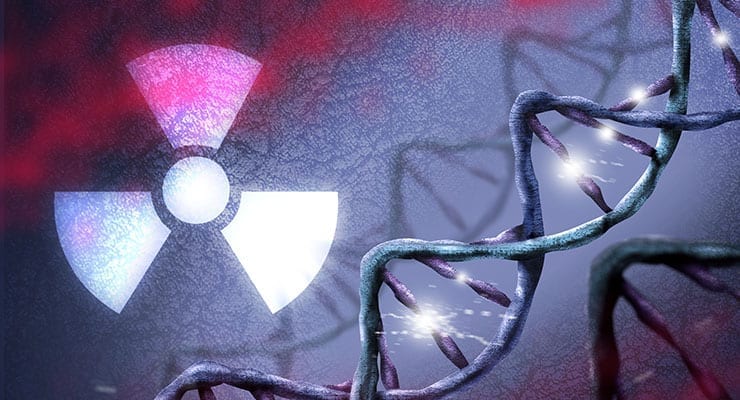The U.S. federal government is offering funding for research to identify helpful biomarkers of radiation injury and and for the development of assays or devices to assist mass casualty triage during a radiation exposure public health emergency
Proposals are sought by for diagnostic tools or approaches that assess absorbed dose or otherwise assist in predicting health outcomes of acute or delayed injuries resulting from radiation exposure. The end goal is to generate data towards obtaining approval or clearance from the Food and Drug Administration (FDA) for utility in a radiation public health emergency.
Threat scenarios for such an emergency include the detonation of a nuclear device; explosion of a “dirty bomb” (conventional explosive combined with radioactive materials); contamination of food or water supplies with radioactive sources, or placement in crowded locations; and attacks or accidents at nuclear power plants. Depending on the event, it is anticipated that there will be hundreds or thousands of immediate casualties and even more individuals who will experience delayed fallout exposure.
For all these exposures, the signs and symptoms of radiation toxicity are often equivocal, and there are considerable disparities in the appearance of early or delayed effects of radiation injuries. In addition, there is significant person-to-person variability in early and delayed radiation damage to organs and tissues in response to a given radiation dose, due to factors such as genetic predisposition, age, body size, partial shielding, underlying illnesses, and immune status.
Since most FDA-approved interventions to save lives must be administered within 24 hours post-exposure to be effective, it is critical to rapidly differentiate between individuals who have been exposed and concerned citizens who have not received an exposure.
Furthermore, it is important to estimate the absorbed radiation dose and to predict the outcome of such an exposure for rapid, safe, and effective medical management of exposed individuals. Therefore, there is a need for generating several approaches that can address the early, rapid assays, as well as diagnostic platforms that can estimate the radiation dose received and predict early or delayed injuries following radiation exposure.
The field of radiation research has made great progress in the development of medical countermeasures (MCMs). Since 2015, the U.S. Food and Drug Administration (FDA) has licensed Neupogen®, Neulasta®, and Nplate® (Amgen), Leukine® (Partner Therapeutics), and Udenyca® (Coherus Bioscience, Inc.) to treat hematopoietic complications of the acute radiation syndrome (H-ARS). However, no biodosimetry approach has yet been cleared by the FDA for use in triage or as a diagnostic tool for irradiated populations.
A previous funding announcement (RFA-AI-18-045) supported approaches to facilitate precise and timely medical interventions, reduce morbidities, and save lives. The consortium made significant advances in identifying novel approaches to assess radiation dose, development of reproducible laboratory protocols, and platforms to efficiently process a large number of samples. However, there are challenges in further development of these approaches such as bridging the signature to clinical samples, rapidly evolving bioinformatics, and rigorous regulatory processes.
The current effort will continue to address and advance the end-use of assays and devices to:
- Distinguish between concerned citizens (who have not been exposed) and the radiation-exposed population
- Determine the radiation dose in the affected group
- Predict acute or delayed radiation injuries to major organ systems in the event of a large-scale radiological or nuclear incident.
The focus of this funding effort is the development and validation of rapid, reliable, inexpensive, and easy-to-use techniques or assays and devices for use in all segments of the civilian population including geriatric, pediatric, and immune-compromised individuals. Research activities ranging from immediate, early, and delayed changes in radiation-related biomarkers, studies exploring the biokinetics of the proposed biomarker signature, and studies to predict the acute or chronic health outcome in one or more organs are requested.
The selection of radiation exposure type, dose level, and dose rates proposed for studies should be relevant to a radiological or nuclear incident and verified by appropriate dosimetry assessments. The ideal radiation signature will be measurable in a non-invasive or minimally invasive way (e.g., finger stick, urine, saliva, or skin scraping as opposed to spinal fluid or complex imaging) that will allow for repeated assays over time, is sensitive to incremental differences in radiation exposure, is specific over a wide range of radiation doses and dose rates and has utility for different qualities of radiation (high and low linear energy transfer).
Studies using human tissue samples or data from radiotherapy patients may be included if the results are likely to be relevant to exposure scenarios due to terrorist or accidental radiological or nuclear attack. However, the use of samples from radiotherapy patients that have been exposed to fractionated radiation doses should be carefully justified as to their relevance to injuries that might be sustained following a radiological or nuclear incident.
Novel Approaches for Radiation Biodosimetry Assays and Devices Development (U01 Clinical Trial Not Allowed). National Institutes of Allergy and Infectious Diseases (NIAID), RFA-AI-24-003. Application due date: 31 May 2024. Letters of Intent due 30 days prior to application deadline.


